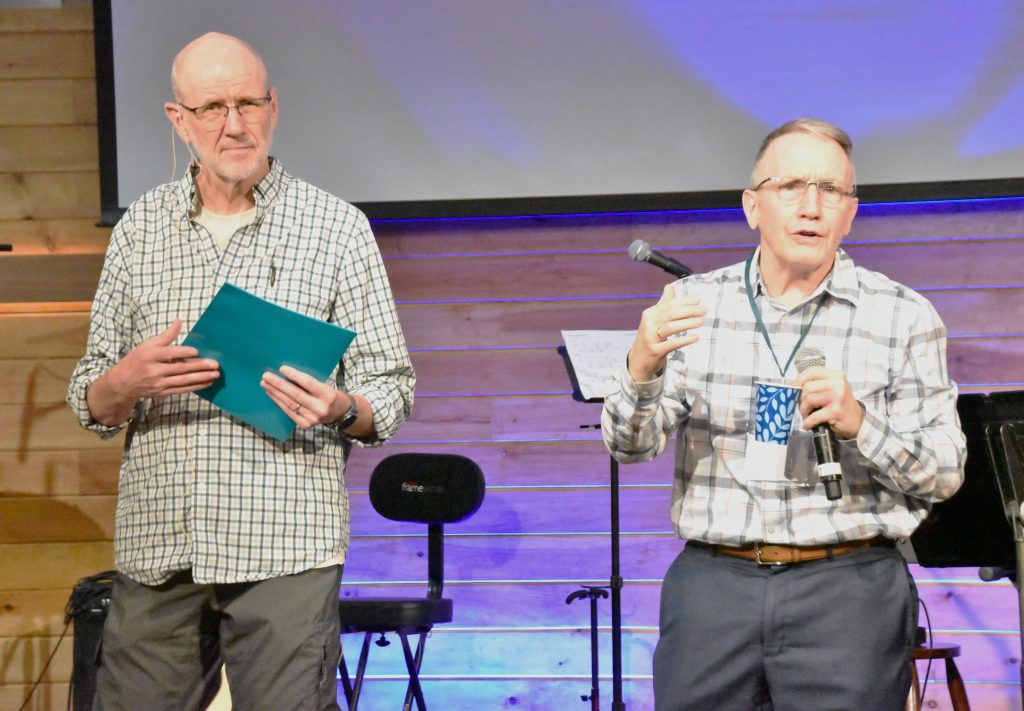At the Stewardship and Generosity Summit, sponsored April 18, by the UM Stewardship Foundation of Greater New Jersey Conference, Scott McKenzie’s keen wisdom poured from the stage and screen, with serious and humorous instruction as captivating as his informative PowerPoint slides.
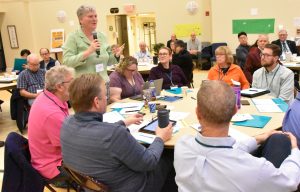
The Rev. Gina Hendrickson, pastor of First Methodist Church of Moorestown, names stewardship ideas she will use with her church to encourage generosity. John Coleman photo
That wisdom filled appetites like the sumptuous lunch that host church Haddonfield UMC served to more than 80 attendees from 36 congregations and ministries. Each of them came to learn how to increase giving in their churches.
What many learned is that generosity follows gratitude, and resources grow from relationships, and that most churches “don’t have a giving problem. They have an asking problem.”
The Rev. Brian Roberts, foundation executive director, set the stage for McKenzie by reviewing giving trends that showed mostly increases in charitable giving, even to religious groups and even during the pandemic. “We’re here today because people continue to be generous in their giving,” he said. “They’re just not giving to us.”
Of course, there is greater competition for that generosity among nonprofits. Religious groups received about 27 percent of all donations to charities in 2022; but that is a shrinking share of all giving to nonprofits.
That’s why Roberts wants to resource churches to help them attract more of the dollars that people want to give. And he wants to do it connectionally, by holding annual summits and helping to “create a movement of learning, growing, and developing new models rooted in God’s grace and our Wesleyan DNA.”
Scott McKenzie, a partner and senior executive at Horizons Stewardship, has helped congregations across the country, including some in Greater New Jersey, make stewardship part of their DNA through capital campaigns, planned giving and other tools and strategies to inspire generosity.
An ordained United Methodist Elder with a Ph.D. in spiritual formation and about 30 years of fundraising experience, he is also a certified coach with C.F.R.E. (Certified Fundraising Executive) status and is currently coaching several GNJ pastors. And he is an author and co-author of four books on stewardship and generosity as keystones of discipleship.
‘Keep it spiritual!’
It’s McKenzie’s focus on spiritual formation that may be most remarkable, especially when he uses it to ground and elevate his teaching about stewardship. “He walks the walk!” said Roberts.
“Keep it spiritual” was the first of five “Principles for Growing Generosity” that McKenzie’s offered. “People learn about giving and generosity through the preaching and teaching they experience at the church,” he explained. “It is essential to lay a spiritual foundation using biblical generosity principles, so people can understand the connection between their generosity and their relationship with God.”
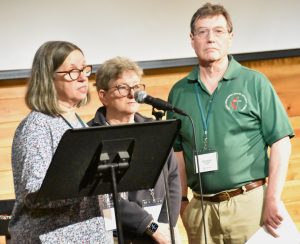
FROM LEFT: The Rev. Gerri Ridings, pastor of Green Creek-Bethel United Methodist Church, one of three “Impact Makers” churches at the summit, describes the church’s “Our Part” community ministry that supplies food to neighborhood children on weekends when school lunch programs are not available. . With her are program coordinator Mary Ann Schellinger and Kent Schellinger. John Coleman photo
In fact, he said, the most important scripture to inspire generous giving is not the usual 2 Corinthians 9:7—“God loves a cheerful giver,” but John 3:16—“ For God so loved the world that he gave his one and only Son, that whoever believes in him shall not perish but have eternal life.”
“Tell Your Ministry Story” was rule #2. “One of the primary reasons people give to any organization is a belief in the mission. People want to give to organizations that are focused on a mission and accomplishing it. Finding ways to tell how your church is accomplishing its mission is key to increasing levels of support.”
The other three principles are:
- Make the Ask—The most common way that churches make the ask is through the annual appeal. But we also should make the ask through websites, planned giving initiatives, capital campaigns and special offerings. Looking at the Horizon’s Integrated Church Funding Model, we need to be sure we are promoting all different ways in which people can partner with the church—not just pledging.
- Measure Effectiveness—We want to be sure that the strategies we are deploying are having the desire effect. Using analytics or even basic metrics will help you determine whether or not what you are doing is actually increasing generosity.
- Build Donor Relationships—”Never talk about people’s money apart from their discipleship,” McKenzie said, quoting church leadership sage Lovett Weems. “Never talk about the church’s money apart from its mission!” He taught other principles of nurturing donor relationships also, starting with the importance of expressing gratitude for donor’s gifts.
Create a Discipleship Path
In barely more than half of the seminar’s six hours, McKenzie taught numerous other, practical principles, while also fielding questions. Included in his suggestions:
- Have prayer and devotions before financial commitments are made.
- Create a “Discipleship Path” that embraces stewardship, giving and generosity (SGG).
- Offer a generosity preaching and teaching series, along with small groups studies.
- Establish a Generosity Team.
- Share life-transformation stories, “the heart of our faith” to help people resonate with the value of generosity.
- Asking committed givers to share their stories that inspire their own generosity.
In addition, “You should know what people give,” he strongly advised, concurring with most stewardship experts that such knowledge can help pastors identify committed and uncommitted leaders and also care for their members. “It will be one of your greatest joys,” he said, “but also one of your deepest sorrows.”
‘New perspectives helped spark creative ideas’
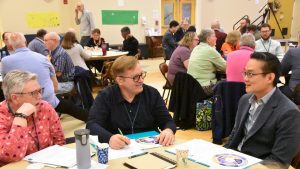
FROM LEFT: Linda Henderson, Robert Haeberle and the Rev. Sam Park, from First UMC in Delran, participate in a table-talk about stewardship challenges and possible solutions John Coleman photo
“This stewardship summit caught the attention of our treasurer, Lori Rapp, who organized a team from our finance committee to attend,” said the Rev. Heather Valosin, pastor of Denville Community (UM) Church.
“Getting outside our bubble and hearing new perspectives helped spark creative ideas and reignite our understanding of generosity as a joyful form of discipleship. We look forward to sharing these ideas with the finance committee and implementing some of them. We also hope to get help through Horizons for long-term planning for the vitality of our congregation.”
Roberts used some of the afternoon session to introduce leaders from three GNJ churches, whom he called Impact Makers, and several more attendees, including from Denville Church. All shared uplifting stories of resourceful, impactful ministries their churches were undertaking to serve their communities.
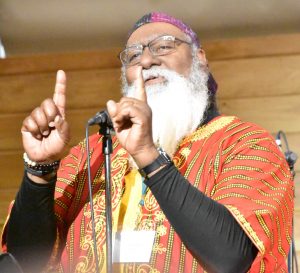
Pastor Tim Merrill describes “Impact Maker” Imani Community Fellowship in Camden (the former Bethel UMC and now a Hope Center), where he forges relationships and creative initiatives with community partners and local residents, including formerly incarcerated men. John Coleman photo
The “summit” began with worship and ended with Communion and a benediction, all sweetened by praise music from Haddonfield UMC’s ministerial staff. In-between, there was McKenzie’s teaching, attendees testimonies and Roberts’ exhortation, encouraging the “congregation” of mostly pastors to believe in the possibilities of faithful, fruitful stewardship.
Perhaps then the most fitting, final feature to add to this worshipful stewardship summit would have been an offering.
MAIN PHOTO: From left: Scott McKenzie of Horizons Stewardship and the Rev. Brian Roberts, who heads GNJ’s United Methodist Stewardship Foundation, co-lead the foundation’s well-attended Stewardship & Generosity Summit April 18. John Coleman photo

